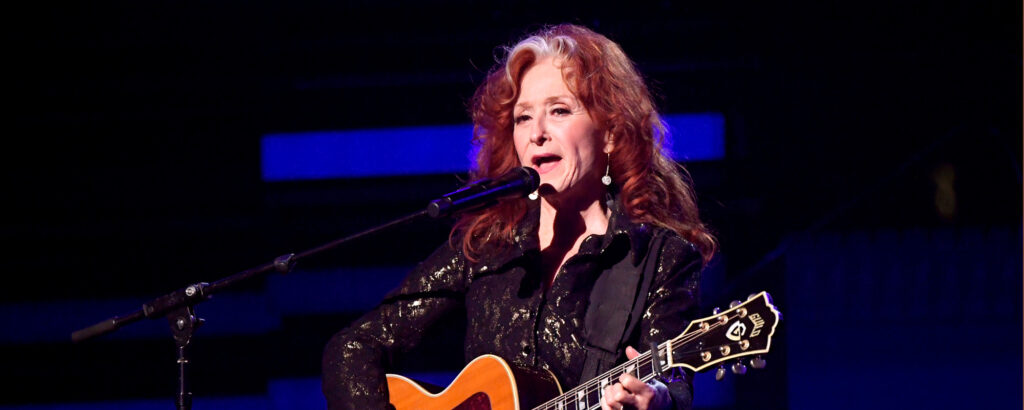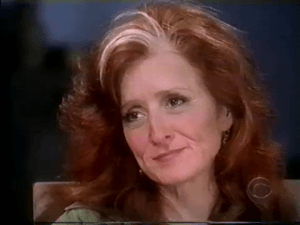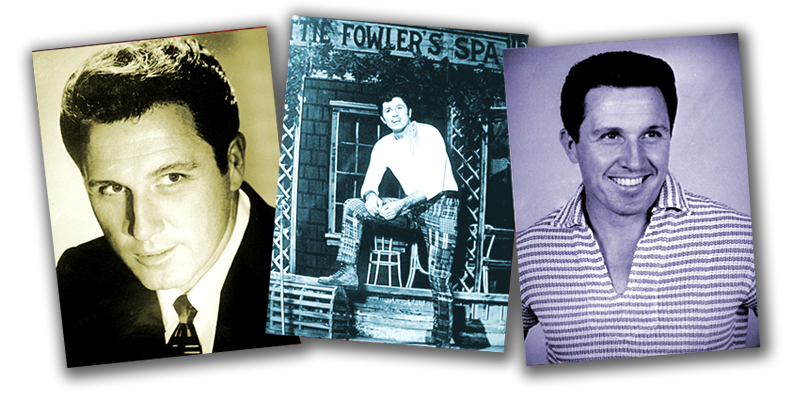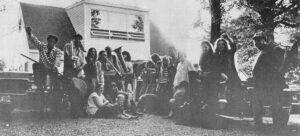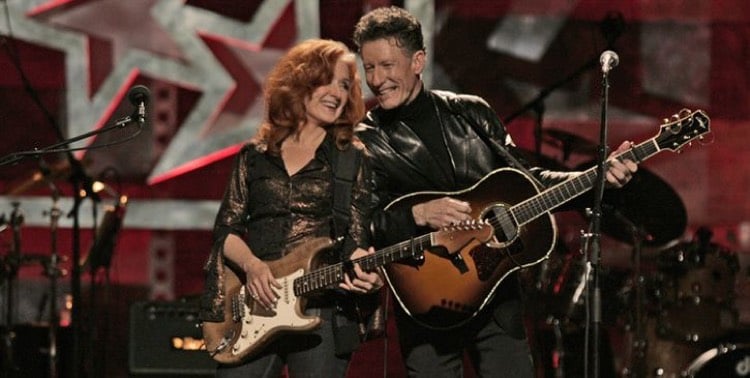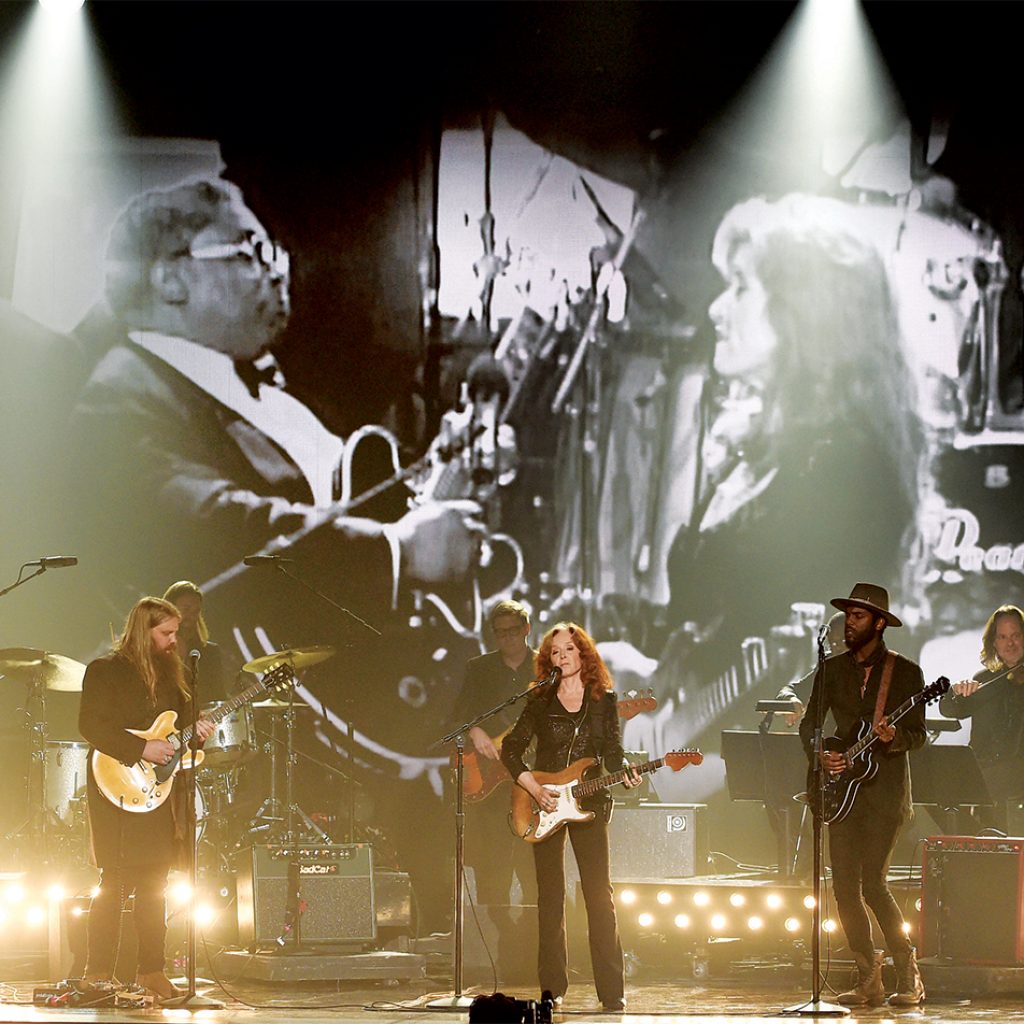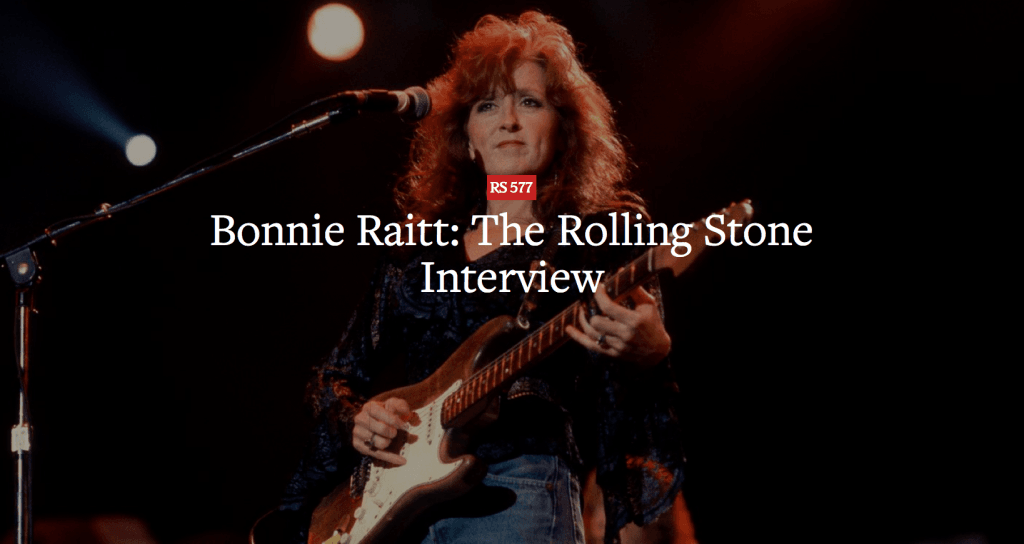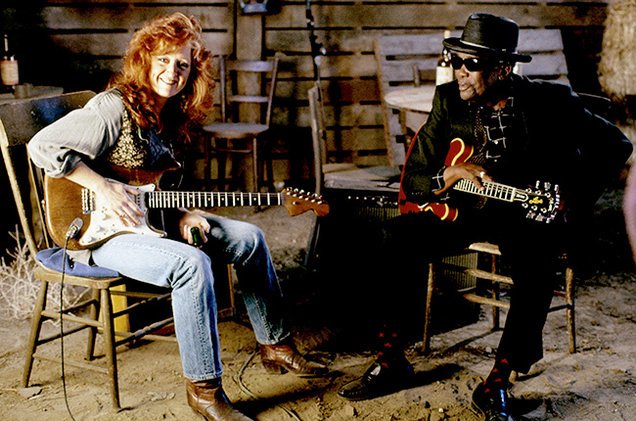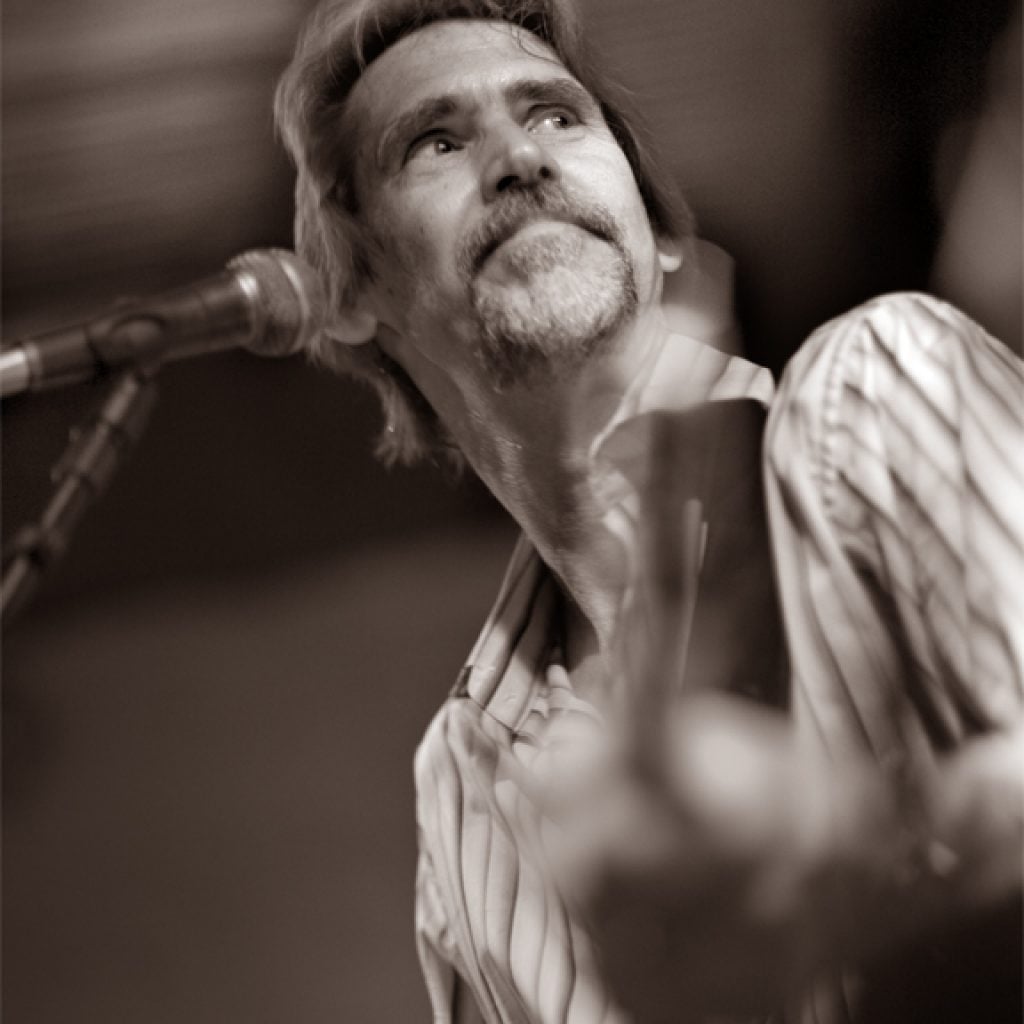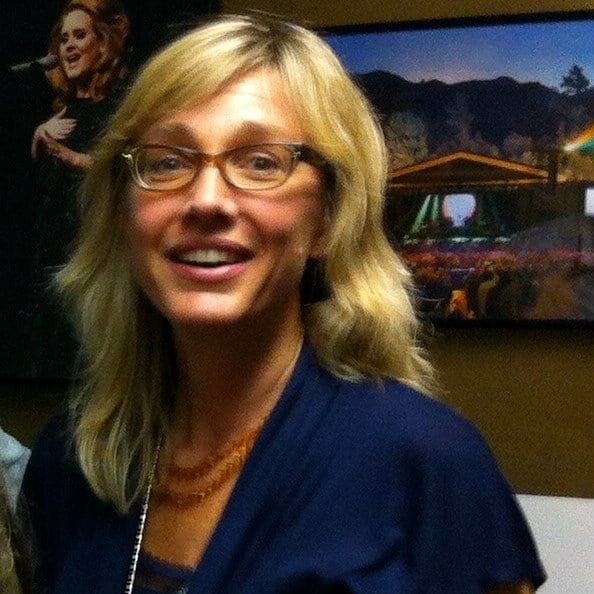Cover photo by Neil Zlozower

By Patricia Brody
BONNIE RAITT was almost a folksinger, part of the plethora of guitar-playing protesters of the Sixties led by Bob Dylan and Joan Baez. Sitting in her girlhood bedroom in a house atop Coldwater Canyon’s peacefully affluent Mulholland Drive, Bonnie, born in Burbank, California, in 1949, was inspired by loneliness to teach herself guitar. “If I’d been able to hang out with other kids, I’d never have gotten into it,” says the daughter of successful Broadway actor John Raitt, best known for his leading roles in musical comedies like Pajama Game, Oklahoma, and Carousel.
The Raitt house—last stop on the school bus route—though somewhat isolated and not particularly conducive to visits with friends, hardly seemed located within earshot of the whiney, mournful tones of a generation of blues guitarists whose techniques and repertoire Bonnie came to adopt. Blues developed far from what Raitt describes as the Los Angeles “blonde-streaked surf scene” whose “political and intellectual vacancy” drove her to a progressive Quaker boarding school in upstate New York. There, feeling more in her element among, as she calls them, “the precocious children of leftist lawyers and actors into modern theater of the absurd and Marxism,” Raitt listened to Pete Seeger records and expressed her own discontent playing Peter, Paul, And Mary and Kingston Trio-type laments on her guitar. “For years,” she recalls, “I wanted desperately to get old enough to be able to go to civil rights demonstrations and peace marches, be a beatnik, grow my hair, and have cheek bones like Joan Baez.”
Encouraged in a musical home where “my mother was my father’s accompanist, and we’d all sit around singing together,” plus five years of piano lessons, Bonnie first turned to guitar, a Stella given to her as a Christmas present by her parents and grandparents, at the age of ten. She enthusiastically pursued her hobby through several summers at camp, in Massachusetts, where her counselors inspired even more longing for contact with the outside world, with their exciting reports of musical events at the nearby Newport jazz and folk festivals.
Then, an album, Blues At Newport ’63 (on Vanguard, S79145) containing tracks by John Lee Hooker, John Hammond, Mississippi John Hurt, as well as several other blues and folk artists fell on Raitt’s fourteen-year-old ears with enough impact to permanently change the direction of her music. “From that point on,” she remembers, “I was split into two parts. One side of me was all Joan Baez, my early idol, or Childe-type ballads, while the other suddenly had to learn whatever the hell it was Mississippi John Hurt was doing on ‘Candy Man’.’’ Being Bonnie Raitt, she learned “Candy Man.”
An acceptance from Radcliffe College in Cambridge, Massachusetts—they didn’t have curfews there—further assured Raitt’s entanglement with the blues. Though she began by majoring in African studies with plans to do a community development, political organizing program, she soon came into contact with a leading figure of what she terms the blues “mafia.” Dick Waterman, manager and promoter for many blues artists and events, seems to have been the catalyst who turned Bonnie’s guitar hobby into a pursuit of somewhat greater intensity. It was at Waterman’s Cambridge apartment that Bonnie met Son House, the first in a long chain of encounters with aging blues giants who were to definitively shape the young woman’s entire career. She did not become a political organizer or a white Odetta (another of her childhood influences). The black woman with whom she is most identified is Sippie Wallace, a blues artist now in her eighties who has been making records since the Twenties, and many of whose songs—”You Got To Know How,” “Mighty Tight Woman”—have become Raitt standards.
Hindered, she says, by a voice more Judy Collins than Memphis Minnie, Raitt has worked continuously for nearly ten years to combine her evocative Delta-style slide guitar with her “white girl’s” vocals to create a memorable sound. Her playing has expanded to include electric explorations on a Gibson ES-175 and a Fender Stratocaster, in close coordination with a five-member band, while her voice has noticeably matured. She’s a long way from the bonier days of just “Freebo [her bassist from the beginning], my little dog Prune, a Matthews amp, and me.” In some ways. Upon the release of her sixth album, Sweet Forgiveness, Raitt does not deny her impatience for the long awaited, frustratingly elusive hit. Yet she maintains a unique hesitancy about making it big. Despite half-hearted forays into the realm of commercial appeal with her last two LPs, Streetlights and Home Plate, she seems to have returned to staunchly guarding her independence. Her most fervently expressed hopes focus on taking the blues into a new form; finding her own sound.
“I’ve been almost making it for a long time,” she says with traces of irony. “My records are never everything to everybody, but I’ve always got another chance to make something new. Once you have a hit, you’ve got to follow it up; that becomes your object or you won’t stay around.” Raitt is apparently not about to disappear from today’s music scene.
* * * *
How did you first learn to play slide?
I just broke off a wine bottle! Well, the style was called bottleneck, so I figured that’s what it was. The only problem was you couldn’t get wine bottles too easily if you didn’t drink, and at boarding school there weren’t a whole lot of wine-drinking orgies.
Were you still playing the Stella?
No, after the Stella I got a red Guild with gut strings. No idea of the model number, but I remember wanting the red one because everyone else had white-topped guitars, and the red one went with my hair. I thought it made me look like an Irish Setter. Later I saved up and bought my first Guild. I forget the number, but I always play an F-50 now. My first National was a copper-colored metal one but it was painted. They used to paint them to look like wood. The one I have now is around a 1929. It has a wooden body which is very unique.
Cambridge, Massachusetts, was a turning point for you. What happened there?
I went there to go to college. I just played guitar as a hobby, but I ran into a lot of blues freaks at the Harvard station, WHRB, and at Club 47 in Harvard Square, a major outlet for musicians like Buddy Guy, Junior Wells, Taj Mahal, and Canned Heat, not to mention John Hurt and Skip James. Strangely enough. I’d rushed to get old enough to catch this great Greenwich Village folk scene I’d heard about, and naturally the year I moved to Cambridge the club closed, and along came The Ultimate Spinach and acid rock. This whole incredible political scene went to pot, literally, but that’s when I met Dick Waterman.
By coincidence?
No, I was already a blues freak when I left California. There was a kind of blues mafia between New York, Philadelphia, and Cambridge—all these esoteric people talking about their blues idols’ eating habits, the obscure 78s they’d find, and Dick was a kind of liaison, but he was unique in his concern for taking care of artists who were still alive rather than trying to revive an era that was dead. Everyone at the Harvard station knew him, and if you wanted to do a blues show, you’d call Dick Waterman. Periodically Son House, Skip James, or Arthur Crudup would come to town. Anyway, one afternoon a friend of mine invited me to this apartment on Franklin Street, and who was there housesitting for Dick Waterman, but Son House. I was just floored. Then I began to meet them all.
All through Waterman?
Dick at the time managed Junior Wells, Buddy Guy, Magic Sam, Otis Rush, Luther Allison, J.B. Hutto, as well as many other traditional bluesmen. The reason it made sense to have so many under one agency was to protect them from the abuse of white blues promoters. Club owners would play one bluesman against the other. They’d say, “Well, we can get Bukka White for $200 less, so why bother with Son House?” Then Son’s manager would have to drop his price in order to get the guy a gig at all. Dick was outraged, and by keeping them all under one agency he could protect their rights. “You’re not going to get any of them to play unless you pay what they deserve,” he’d say. I started traveling around with Dick, driving Son, Skip, or Sleepy John Estes to the blues festivals, and I became real tight with them. With Buddy or Junior Wells, guys in their forties, that was fun, but with the older men friendship was difficult. John Hurt died right before I met Dick, and that was just the beginning of a series of five or six deaths, which was terribly painful for those who knew them. But still, meeting them and knowing them was overwhelming; I can’t describe it.
Of all these legendary figures, who influenced you the most?
That’s impossible to say. One of them had to be Fred McDowell, who stayed with Dick when he was in town. He thought it was really funny, this little eighteen-year-old girl playing guitar, but he was flattered at my interest, and he taught me. Also, I’d say I emulate Muddy Waters’ style.
Did you actually try to imitate him or any of the others?
Not exactly. You can’t help but learn if you sit and play music with somebody. It was like being stung with a guitar style, and I had to play that way, or else it didn’t feel good. It’s not like a singing style where you try to avoid sounding like someone else.
When did you develop confidence in playing ‘their’ style?
During my first gig with Taj Mahal one afternoon. I took out my National and started playing some Fred McDowell stuff, and Taj, who didn’t know me, looked over and said, “hey all right.” He came over, took out his guitar, and we started playing a wordless duet, him playing Willie Brown to my Charley Patton [both Delta blues figures]; you know, just throwing blues licks off each other, not saying anything. Finally he reached out his hand and said, “Hello, my name is Taj Mahal.” [Blues interpreter] John Hammond has been a great help to me. I had a crush on him for years. Being a girl helped. These musicians came in, heard me sounding—or trying to—just like them, and they’d be flattered, and helpful. If I’d been a young guy doing a show just like John Hammond’s, he might have felt a bit threatened. I wasn’t playing as good as them, but they were real tickled that I was into their style.
How did you develop your own style out of the traditional blues?
My style is probably the result of a problem. My voice, actually soprano, is around five keys up from where Robert Johnson or Son House would do a song, say in Spanish open G tuning. I can’t tune the strings up or down to get that open octave;
I have to capo up three or five frets to get the same tuning, which is the only way to make the guitar part sound good. You lose the octaves—with no cutaway you can’t get your hand up there, and you’ve got only around three frets left to play slide. My National has a new, hybrid neck with fourteen frets, and that’s one of the reasons I went to electric, for the longer neck. Just adding my voice to a Fred McDowell guitar part would bring about a unique style, though.
Do you have trouble with your voice?
As my throat doctor says, “You’re trying to sing that Afro style.” I lose my voice often, because I do push it a lot to sing more blues, soul, or R&B. It was hard to do “Walking Blues” (on Bonnie Raitt) for instance, but I was not born with a voice like Mavis Staples or [contemporary English blues singer] Jo Ann Kelly who sounds uncannily like Memphis Minnie, or any ballsy, chesty blueswoman. My voice is neo-Judy Collins.
You don’t really sound like her.
Well, I’ve beaten my voice down over the years by pickling it with alcohol and screaming and yelling, so it’s gotten lower. If I was to sit here and play some blues for you now, and not worry about singing, I’d play what I feel is real good. I’d have liked to play more Fred McDowell and Robert Johnson stuff, but I have kind of this bird voice. As I was learning how to sing in public, I found that putting the tune in my key took away a lot of beautiful positions. My style is not a B.B. King lead guitar solo style, but just kind of half rhythm, usually in the key of E or A drawn from Muddy Waters, Brownie McGhee, John Hammond, Fred McDowell. It limits what I can do. Instead of doing a song in D, like most guitarists who really know their way around the neck, I move the capo around because I don’t want to miss that Muddy Waters-type blues riff. That’s the only way I can get the sound I want.
Do you still have trouble coordinating your vocal range with your guitar playing?
Yes, though I started out doing it as soon as I did my first tour. I’m not saying I’m satisfied with my solution to the problem, but I like to do those types of tunes. When I’m playing blues, I feel the way Fred McDowell’s or John Hammond’s playing makes me feel. I feel real big. So I just do it and don’t listen back to it.
Is Sweet Forgiveness very different from your other LPs?
Both Streetlights and Home Plate were too slick for my taste. I didn’t have enough of a role on them, though I did do a lot of the arranging which was great for me to learn about. There are no standard blues on Sweet Forgiveness because I think there are only a certain number of shuffle blues in E that you can play. Having done so many things like “Love Me Like A Man” [Give It Up], “Finest Lovin’ Man,” and “Mighty Tight Woman” [both on Bonnie Raitt], if I did another it would be almost the same. I did “Big Road” on the first album [Bonnie Raitt] and “Give It Up” and “Let Me In” on the second and third [Give It Up and Takin’ My Time], so if I did another dixieland tune, the albums would all start to sound alike. But I still do those songs ‘live.’ “Love Me Like A Man” is one of my favorites. Sweet Forgiveness is much funkier than Home Plate. There are no strings, hardly any horns, and just a couple of backgrounds used. Probably the main difference with this record is the use of my ‘live’ band. I relied a lot on John Hall’s and Billy Payne’s guitar playing in the past. They’re doing so well with Orleans and Little Feat, I felt the time had come to wean myself from their influences.
How much guitar do you play on Sweet Forgiveness?
Five cuts. I play slide on “Three-Time Loser,” an old Wilson Pickett tune on the back of “Mustang Sally,” and also on a song which just kills me, “About To Make Me Leave Home Boy,” which I found on a Syl Johnson record. He’s a guy who sounds like Al Green. Then there are two acoustic numbers I play on: “Louise,” an old one by Paul Siebel, and “Home” by Karla Bonoff. We did those two ‘live’: Fred Tackett, an absolutely incredible player, and I on acoustic guitar; Dave Grisman on mando-cello, and Freebo on bass, and that’s it. Haven’t done it like that in a long time. We just played, and I sang to the people in the room. Oh, and I play a Johnny Smith guitar on “Opening Farewell” off Jackson’s first record.
Do you think you’re still developing your guitar playing?
Yes, though I may put more time into singing. I don’t write so I want to make up for it by singing and arranging and choosing the tunes. It’s really hard to find songs, since it’s my sixth album and so many of my favorites are on the first three! Plus I have to compete with so many other interpreters: Maria Muldaur, Linda Ronstadt, etc. But people ask, “Why can’t you do another one like Give It Up? which they seem to like the most. If I do, that’s all it will be, a repeat! I think what I’m doing now is what I have to, make the styles from those older blues people into my own. It may not be a three-chord blues song; maybe you can’t classify it now. I hate to be called a blues singer or a folkie. This is a new kind of music, part soul, part blues; it’s a hybrid! I don’t play exactly like a black person or a white person or a boy or a girl. People complain that I don’t do as much blues as I used to, but that’s not quite true. The blues have moved into the music in a different way. Many people are taking the blues form and moving it ahead so it’s not so limited. Little Feat does that, so do Phoebe Snow and J.J. Cale, and I want to do that, too. I don’t think the blues has to lose its originality as it draws from other sources. Having worked with the band on this album—with guitar, voice, and all the instruments—will lead to something very creative.
What led you to play more electric?
I wasn’t happy with my sound anymore. You can play acoustic in front of 3,000 people but you’re not going to get much meat out of it, especially with a band behind you. With this Gibson ES-175, which is really still a big fat acoustic hollowbody, I have so much better ability to control my tone. As I got more into singing uptempo blues, I felt stupid sitting down, looking up at my band who are all around 6’4″ or so. Last time I played ‘live,’ I picked up my National and played exactly as I did in the past! You can only go so far with certain things.
Has electric had an effect on your actual technique?
I stand up, and I feel like I’m playing stronger. I used to think the only way to hunker down on a guitar was to hunch over it and stomp my foot. Now I don’t feel as enclosed. You’d have to hear; somebody who had been going to my concerts might notice, I’m playing better this year than I did two years ago. The flow of it sure feels changed. Especially for a recording session, I can bend the strings a lot easier on an electric guitar. And I love having two guitars to switch between; I used to just tune my Guild up and down when I wasn’t carrying the National.
So you feel you’re moving ahead musically with the electric?
Well the songs are harder. I used to play pretty easy three-chord folk tunes. And I have a built-in guitar teacher. Will McFarlane, my lead player. If he hears me play A minor, and it was supposed to be some bizarre diminished chord, he stops the band and says, “Okay Bonnie, we have to move ahead now.” So I learn as the situation calls for it.
Do you think of yourself more as a singer/bandleader than a guitarist?
Not at all. I play better than I ever did for many songs. But with a band of course you won’t notice as much as when it was just me and Freebo lugging our own equipment around. I used to cover the entire scene—rhythm taps with my thumb, lead—but now the piano and the other guitar can do some of the kicky stuff, and I can concentrate on single, higher, more sustained notes. Half the fun of slide guitar is to get more sustain, and the compressor makes it even more effective.
Did you ever have formal lessons?
No; if you watch my hands you can tell.
What do you use for a slide?
I still make them out of wine bottles, relatively cheap red wine. I flipped the bird a lot when I was a kid in California, so I knew how to isolate my middle finger, and I just naturally put that to use. Fred McDowell made his slides from Gordon’s gin bottle necks, and they were only about one and a half inches big. He’d have it on his little finger and move his hand around a lot, like a violinist. My slide goes all the way from the second knuckle to the top of my finger, and my hands are smaller than his so I can get a whole chord easier. [Ed.Note: Honest Tom Pomposello, McDowell’s former bassist, points out that McDowell switched between his little finger for material in open A and G tunings and his ring finger for E tuning which comprised the largest part of his repertoire. The McDowell tunes which Bonnie performs, however, are mostly in open A and G.]
Do you damp when you play slide?
John Hammond once told me to use the finger to the left of where your slide is to damp, so that when you’re coming up the neck it would make the note ring clearer, but I’d already learned to damp just with my palm, and I couldn’t change it. I use the palm of my right hand to kind of muffle the sound when I pick with my thumb, and I use my thumb to get that thumpy kind of bass. I also use all three fingers when I pick. I sort of precariously balance my slide, so the middle finger wasn’t the best choice because when you go to chord you have to learn how to keep the bottleneck from falling off.
You said before your tunings are somewhat limited?
Yes, I usually use open G, [D, G, D, G. B, D, low to high] or A [E, A, C#, E, A, E, low to high] for slide, and I move the [Bill Russell] capo up three frets since most of the songs were in C. I have trouble with the capo because I move around so much during the show that I need one you can slide around easy that doesn’t bend the strings.
Has your changing style determined the guitars you choose to play?
I rarely use the National now, though a ‘live’ performance can sometimes be kind of a re-creation of what my concerts used to be like. I’ll tell you, for acoustic guitars, I think Guilds are terrific. They’re also a great blues guitar. They’re nice and big, and I like the ratio of the bass to the brightness. The necks are smaller on Guilds, which is good for me since I have small hands.
When do you use the Guild?
At home. I don’t walk around peering into shop windows, but this one I just happened to see at a time I knew I wanted a big bright jazz instrument, and the price was right. My Gibson has a narrower neck, too. I string it with an unwound .020 third string to bend it easier, because when Fred played electric, I always liked the tone—whiney. If you can get it right it sounds just like a human voice.
You use a Stratocaster for your electric slide playing?
Yes. All the people whose playing I love use Strats: John Hall, Lowell George, Ry Cooder. But I’d like to get another Strat to fool around with as a regular lead guitar, you know, as a singer. I use a Gibson for lead parts; my Strat’s set up just for slide with the action raised. I don’t have to do any real playing with it, just sort of bend the strings and slide. I’d feel guilty about getting another guitar if I didn’t use it a lot, but maybe that would be a good idea to make me practice more.
How has your other equipment changed as you get away from strictly slide playing?
Actually I’ve added equipment to enhance my slide work. When we were on the road together Lowell [George] gave me one of those MXR compressors, and I think you’ll see a difference between the way I played “Sugar Mama” on Home Plate and on the two slide tunes I do on the new record. I first moved out to California to work near Little Feat—I think they’re one of the most exciting bands in the world—I wanted to be near them and Jackson Browne, some of the musicians I admire the most. I’m such a fan of Lowell’s music, but I don’t want to imitate him. The compressor has given me a whole new scope of sound; it’s made me have to work harder to find my own blend. As I get more sustain out of the notes, I find my old style becoming limited for my taste, and I’m using less slide.
What about your amps?
Recently I got a Music Man 212— Will’s got a 210-HD—real nice because it has a built-in preamp. Anytime I’d play an old guitar through a Fender amp, the preamp would overdrive. But I don’t seek out certain types of guitars or amps for the purpose of collecting. Being Quaker-Scottish I don’t believe in stocking up on things I don’t need. Also, I save myself the pain of having anything ripped off by not becoming too emotionally involved with the intruments I have. Besides the compressor I have an MXR phaser, which I sometimes like to play an acoustic guitar through, and an MXR Noise Gate. I could just as easily be playing through a Pignose or something. I don’t really care, but this combination—the Music Man with those three boxes—seems to work out best onstage.
How do you adjust to different playing situations?
There is a problem with how different things sound in different halls. I’m amazed at how the guitar sound varies. It pisses me off sometimes; you feel like you have no control. But we have a really wonderful system custom-built for us by a company called Silverfish Audio [Box 9293, Rochester, NY 14625] which seems to project our music quite well—a kind of middle-rock sound, I guess you could say—to just about any size hall. Whatever they do—a new way of miking and monitoring—works. Jesse Colin Young uses them; so does Little Feat. We couldn’t use the same setup as The Marshall Tucker Band, you know, or on the other hand, what Judy Collins has. I think what we’re going to see in the future is all custom-built amps. There’s a guy named Howard Dumble [26th Ave. and Cliff Drive, Santa Cruz, CA 95062], now making amps for Little Feat and Jackson, whose stuff I’ll probably start to use soon, too. His amps are just right for a particular sound, like the overdrive that Dave Lindley [guitarist for Jackson Browne] likes to get.
You’ve got a raised action on your Strat. What about your other guitars?
I’d say about average.
What strings and other accessories do you use?
For the Strat I use Darco singles. The gauges are .013, .016, .022, .036, .044, .056. On the Gibson, medium gauge Sonomatics; for the unwound third string, a .020. On the acoustics, medium or heavy, usually D’Merles. The main thing about my style is fingerpicking; I don’t have a flatpick. I use clear, plastic Dobro fingerpicks. If I lose my pick bag—which is really a little cosmetic case where I keep my two capos and all my picks—, on the road, it’s really hard to replace them. When I do find thumb- and fingerpicks that fit, I buy about 300—well, at least a whole bunch.
What do you do about your nails?
I’ve never been able to have nails! Occasionally, when I have two weeks off, they grow a little. Once I bought these fake nails—because never in my life will I be able to have long ones—, so I got fake ones and painted them, and stood in front of the mirror all day, making weird gestures and admiring my hands.
Sippie Wallace has meant a lot to you. Are you still in touch with her?
Oh yeah, we still do a lot together. We’re planning to make a movie with another woman friend of mine, kind of a documentary on this ever-present theme of being a woman in a man’s world, trying to run your own life or lead your own band. Many women are just “produced” —someone else puts their band together for them. Not that many lead their own band, which Sippie kind of did in her time.
Many female musicians express so much frustration and resentment regarding their difficulties in breaking into or coping with the music business. Have you run into this?
It’s a terrible problem. It hasn’t hindered me so much, but I hear about it all the time. You know it’s hard for guys to break in, too; there are just too many musicians around, especially guitarists. It could get easier if there were more women instrumentalists just sort of sprinkled around in more bands, and I don’t mean the all-girl band situation, exploited for its own sake.
Can you think of any way that you, as a woman musician who has made a breakthrough, can help?
What’s so hard is, women aren’t heard enough to be in the position to be hired. I won’t fire a member of my band to bring in a woman, but if I needed a replacement, and I heard a woman who was great, I’d love to hire her. Unfortunately, my music isn’t established enough, but I hope in the next year or so to do something to try to help—start a record label or create a special auditioning outlet for women. I was lucky, I played the guitar, which seemed like a gimmick. And one of the reasons I got to where I am is because I was cheap. Because when you hired me as an opening act, you didn’t have to hire a whole band, you just hired me, and then you only had to pay one person. I carried my own guitar, I did a little blues, some ballads—and I didn’t threaten the male act on the bill.
Do you still listen to records?
All the time. That’s how I learned! I wasn’t going to ask those guys to sit and teach me. Like when Fred would play “Write Me A Few Of Your Lines.” a tune of his that I do, I couldn’t figure out what the hell he was doing with that IV chord that was all discordant and dissonant. I knew it wasn’t a barre on the fifth fret— that would have been just a straight chord. That’s the main thing I learned from watching: he played a C chord in Spanish, open G, tuning; he strummed it as if it were a C and it made that wonderful half-IV, half-tonic chord. Some things I couldn’t have learned from records, only from watching.
Do you listen to any of your contemporaries?
Sure. I listen to my friends, whom the English refer to as “the tequila circuit.” John David Souther, Jackson Browne and his band, and Little Feat. I also love Maria Muldaur, Valerie Carter, Linda Ronstadt. You know I’m as much a product of James Taylor and Lowell George as I am of Hubert Sumlin and
Fred McDowell. I don’t associate myself exclusively with the blues. That’s really just a journalist’s label. ■
A Selected Raitt Discography
Solo albums: Bonnie Raitt, Warner Bros., 1953; Give It Up, Warner Bros., B-2643; Takin’ My Time, Warner Bros., B-2729; Streetlights, Warner Bros., B-2618; Home Plate, Warner Bros., 2864; Sweet Forgiveness, Warner Bros., BS-2990. With others: Various artists, Ann Arbor Blues & Jazz Festival, 1972, Atlantic, SD 2-502; The Pointer Sisters, That’s A Plenty, Blue Thumb Records, (c/o ABC Records), 6009.
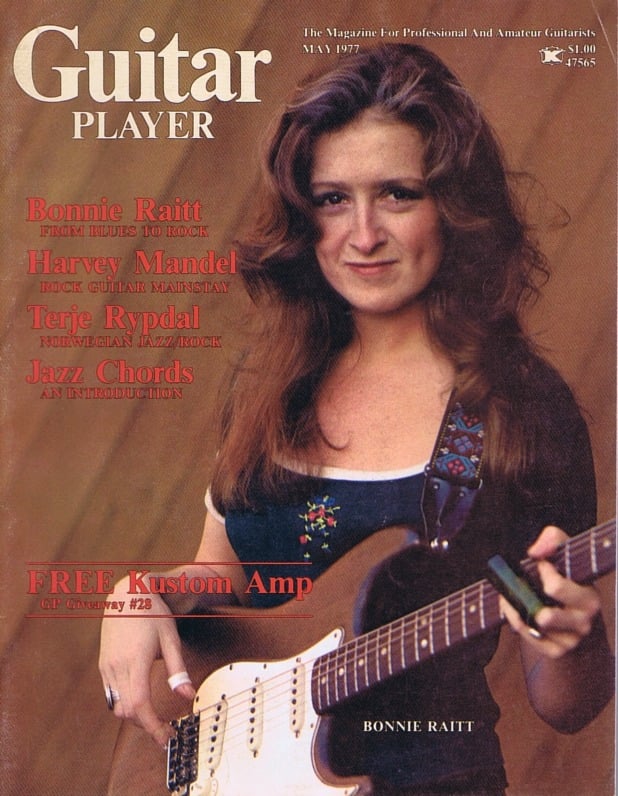












 Visitors Today : 62
Visitors Today : 62 Now Online : 0
Now Online : 0






